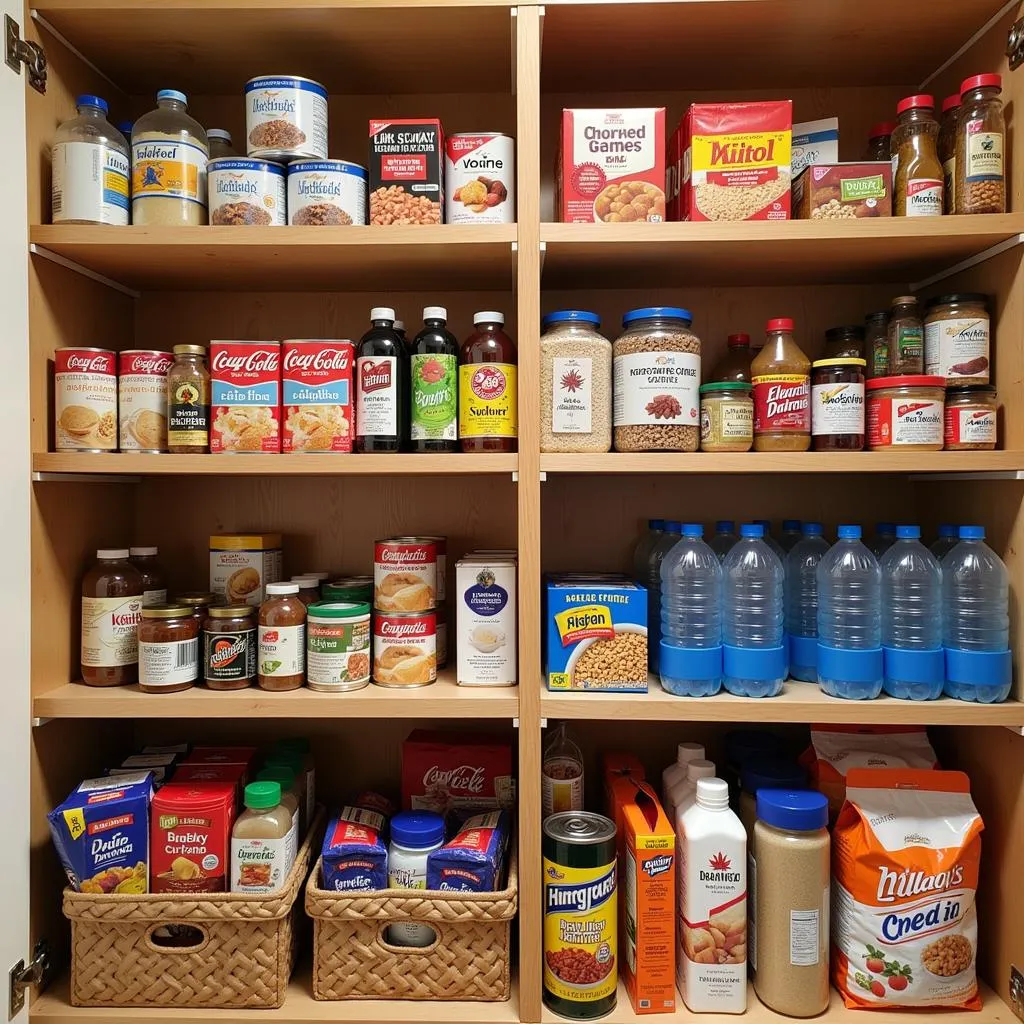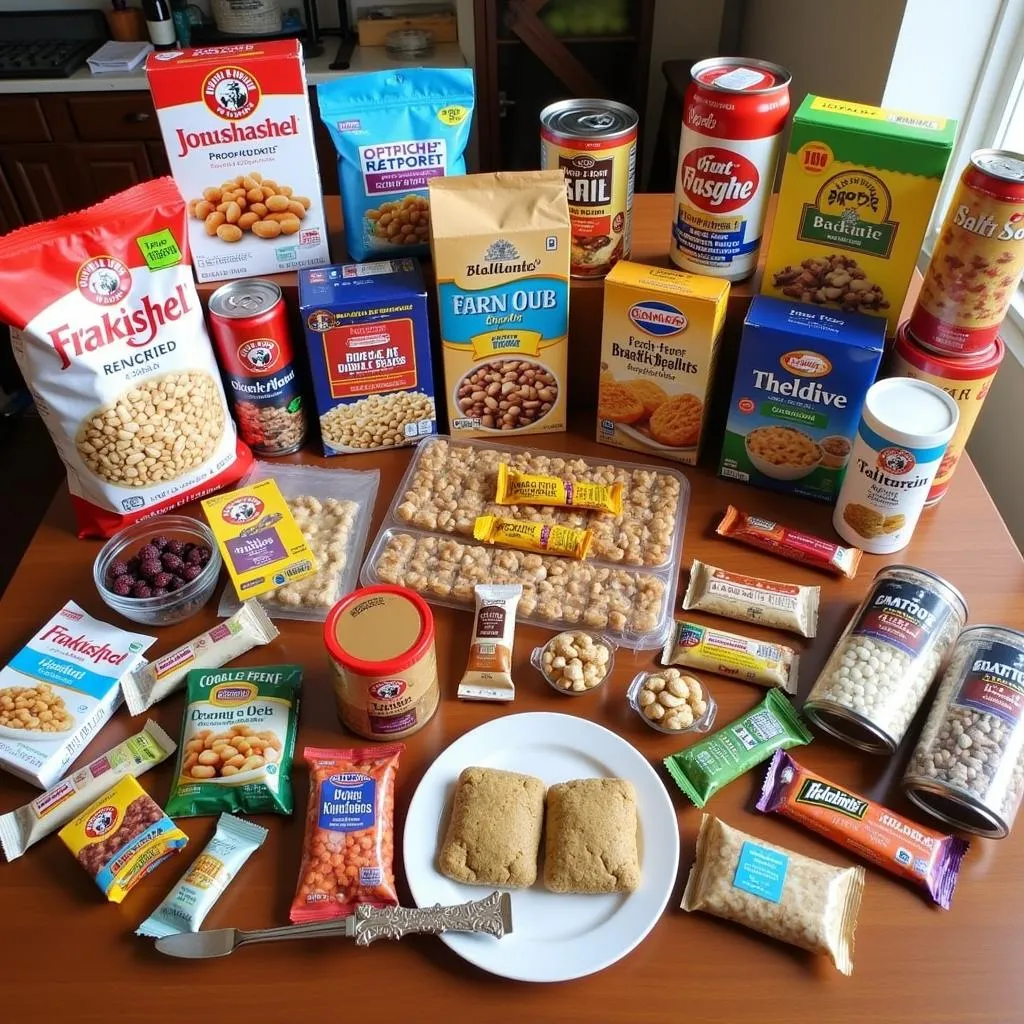In a world where unforeseen events can disrupt our daily lives, being prepared is no longer just a suggestion, it’s a necessity. One crucial aspect of preparedness is having a supply of Emergency Dry Food readily available. But what exactly should you be looking for, and how can you ensure your emergency food supply will truly sustain you when you need it most? Let’s delve into the world of emergency dry food and equip you with the knowledge to build your own reliable pantry of sustenance.
Understanding the Importance of Emergency Dry Food
Emergency dry food refers to non-perishable food items that require no refrigeration and minimal preparation. These lifesavers can be stored for extended periods, providing sustenance during natural disasters, power outages, or any situation that disrupts access to fresh food.
 Emergency Food Supply Pantry
Emergency Food Supply Pantry
But why is emergency dry food so crucial?
- Shelf-Life: Unlike perishable foods, emergency dry food boasts an impressive shelf life, often spanning several years. This longevity ensures you have reliable nourishment on hand when unexpected events strike.
- Ease of Storage: Requiring no refrigeration, emergency dry food can be easily stored in cool, dry spaces, making it convenient for even those with limited storage options.
- Nutritional Value: Don’t be fooled into thinking emergency dry food is all about bland survival crackers. Many options offer essential vitamins, minerals, and calories necessary for maintaining energy and health during challenging times.
Building Your Emergency Food Supply: Key Considerations
Creating an emergency food supply doesn’t have to be an overwhelming task. By focusing on a few key considerations, you can build a well-rounded pantry that will provide comfort and sustenance when you need it most.
1. Duration and Quantity: How Much Emergency Dry Food Do You Need?
The amount of emergency dry food you should store depends on your individual needs and circumstances. A general rule of thumb is to have a minimum of a 3-day supply per person. However, aiming for a 2-week supply or even longer is ideal for increased peace of mind.
2. Dietary Needs and Preferences
When stocking your emergency pantry, it’s vital to consider the dietary needs and preferences of everyone in your household. Allergies, intolerances, and special diets should be factored in to ensure everyone has access to safe and suitable food.
 Family Choosing Emergency Food
Family Choosing Emergency Food
3. Variety is Key
No one wants to eat the same thing day after day, especially during a stressful situation. To combat “emergency food fatigue,” aim for variety. Include items from different food groups to keep your taste buds engaged and ensure a balanced intake of nutrients.
Don’t forget about comfort foods! Familiar favorites can offer a much-needed sense of normalcy and comfort during difficult times.
4. Water: The Elixir of Life
While not technically “dry food,” access to clean drinking water is paramount in an emergency. Store at least one gallon of water per person per day, aiming for a 2-week supply.
Exploring Emergency Dry Food Options: From Basic to Beyond
Now that you understand the key considerations for building your emergency food supply, let’s delve into some specific emergency dry food options:
The Essentials: Building a Foundation
These pantry staples form the backbone of a reliable emergency food supply:
- Grains: Rice, oats, pasta, and quinoa are excellent sources of carbohydrates, providing energy and sustenance. Opt for quick-cooking varieties that require minimal fuel and water for preparation.
- Beans: Packed with protein and fiber, dried or canned beans are a nutritious and versatile addition. Choose from black beans, kidney beans, chickpeas, and lentils for a variety of flavors and uses.
- Canned Goods: Canned fruits, vegetables, soups, and protein sources like tuna and chicken provide essential vitamins, minerals, and protein. Look for low-sodium options when available.
- Nuts and Seeds: Offering healthy fats, protein, and fiber, nuts and seeds make for a calorie-dense and nutrient-rich snack. Choose from almonds, walnuts, chia seeds, or sunflower seeds for satisfying options.
Beyond the Basics: Elevating Your Emergency Pantry
While the essentials provide a solid foundation, consider incorporating these items to enhance your emergency food supply:
- Freeze dried astronaut food: For a fun and unique addition to your pantry, explore freeze-dried astronaut food. These meals offer a novelty factor while still being shelf-stable and easy to prepare.
- Mainstay emergency food rations: For a pre-packaged, long-lasting option, consider mainstay emergency food rations. These rations often come in sealed pouches with a shelf life of up to 25 years.
 Variety of Emergency Dry Food
Variety of Emergency Dry Food
- Dried Fruits: Naturally sweet and shelf-stable, dried fruits like raisins, cranberries, mangoes, and apricots provide a boost of energy and essential nutrients.
- Protein Bars: For a quick and convenient source of protein and energy on the go, consider adding protein bars to your emergency kit.
- Powdered Milk and Alternatives: Powdered milk can be a valuable source of calcium and protein. Explore shelf-stable plant-based milk alternatives like almond milk or soy milk powder for non-dairy options.
Storing Your Emergency Dry Food: Tips for Longevity and Freshness
Proper storage is crucial for maintaining the quality and safety of your emergency dry food. Follow these guidelines to ensure your supplies remain fresh and ready when you need them:
- Cool, Dry, and Dark: Store your emergency dry food in a cool, dry, and dark place, away from direct sunlight, heat sources, and moisture. A pantry, basement, or closet are all suitable options.
- Airtight Containers: Transferring dry food items from their original packaging to airtight containers can help extend their shelf life by preventing moisture and pest infestations.
- First In, First Out: To minimize waste, practice the “first in, first out” method. Rotate your emergency food supply regularly, using the oldest items first and replenishing with fresh stock.
Emergency Dry Food: Peace of Mind in Uncertain Times
Building an emergency food supply is a proactive step towards ensuring your family’s well-being during unexpected events. By choosing a variety of nutritious, shelf-stable foods and following proper storage techniques, you can create a reliable lifeline of sustenance and peace of mind. Remember, preparedness is not about panicking; it’s about taking responsible steps to face the unexpected with confidence and resilience.
FAQ: Addressing Your Emergency Dry Food Questions
1. What is the shelf life of emergency dry food?
The shelf life of emergency dry food varies depending on the specific product. However, many items can last for several years, with some extending up to 25 years or more. Always check the expiration dates on your food items and rotate your stock regularly.
2. Can I include pet food in my emergency dry food supply?
Absolutely! If you have furry family members, don’t forget to include their dietary needs in your emergency planning. Stock up on a supply of their regular food and any necessary medications.
3. How often should I rotate my emergency dry food?
It’s recommended to rotate your emergency dry food at least once a year. This ensures that you’re using the oldest items before they expire and replenishing your stock with fresh supplies.
4. Can I store my emergency dry food in my garage?
While a garage can seem like a convenient storage option, it’s not ideal for emergency dry food. Temperature fluctuations and exposure to pests can compromise the quality and safety of your food.
5. What about cooking during an emergency?
Having a plan for cooking during an emergency is essential. Consider investing in a camping stove or other alternative cooking methods that don’t rely on electricity or gas.
Need More Guidance on Emergency Preparedness?
For more information on emergency preparedness and resources available to you, visit our website for detailed guides and expert advice. Remember, we’re here to support you in every step of your journey towards building a safer and more resilient future. Contact us at Phone Number: 02437655121, Email: minacones@gmail.com Or visit our address: 3PGH+8R9, ĐT70A, thôn Trung, Bắc Từ Liêm, Hà Nội, Việt Nam. We have a 24/7 customer service team.